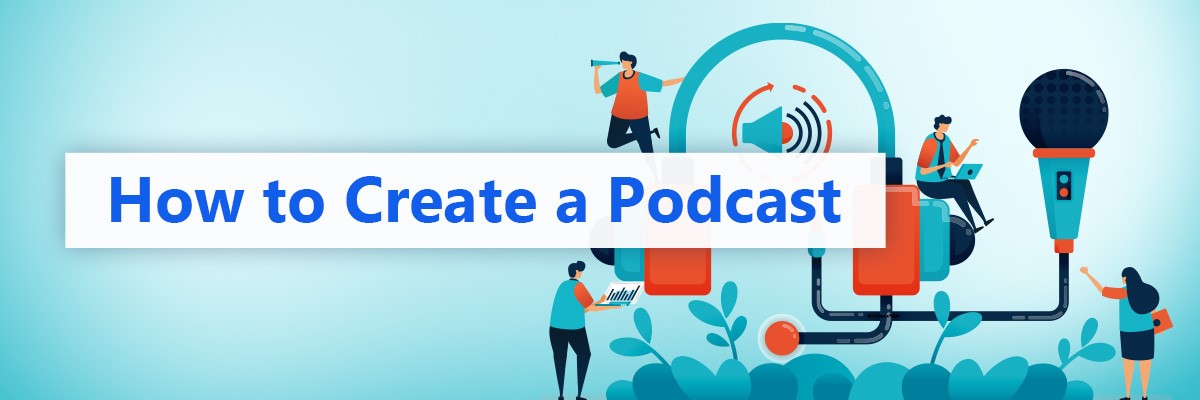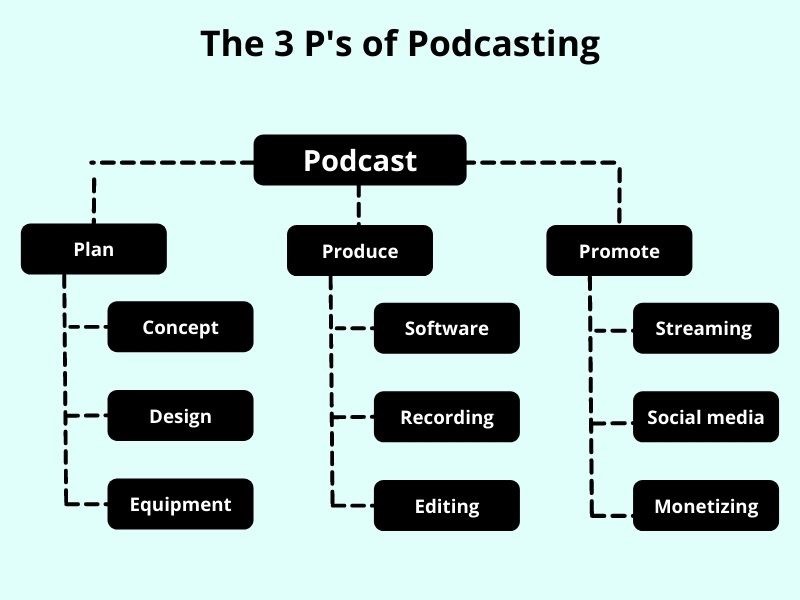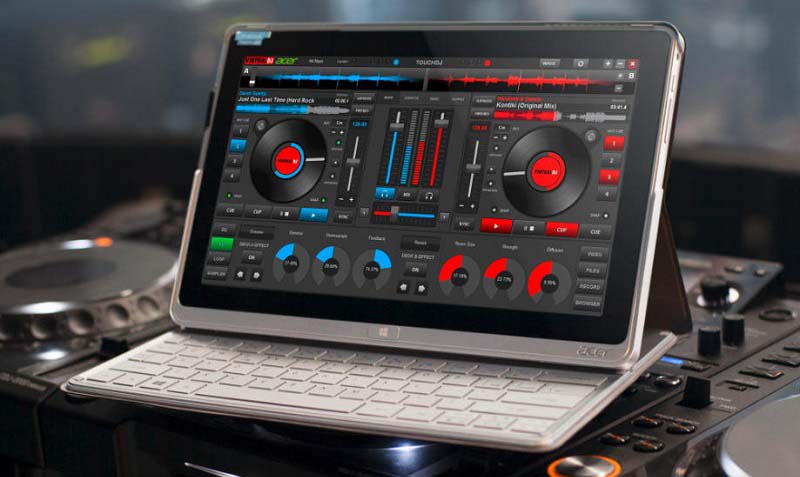Get to know the best sound editing tools
How should sound editing be done to produce a podcast audio file? The steps of making a podcast and editing the sound are done before uploading the podcast and include the following.
- Upload audio files in special software for editing podcast files
- Edit (cut, add, etc.) on the raw audio file
- Adding sound effects to the edited audio file
- Add music to the podcast to add interest to the edited audio file
- Using special sound effects to transition between different parts of the podcast (for example, after leaving the intro, you can use a static sound effect. This effect shows that your podcast has entered the next part and from the intro is out.)
- Editing of music files added to the edited file (music-related files should not be used completely, and only a part of them should be used.
In the following, we will examine the first step and the software you can use in this field.

Explanations about audio editing for podcast production
Using special sound effects and music and cutting or cutting extra parts of your podcast recording can help you make your audio content available to the audience as you like it. Music and sound effects can create a special harmony between your recorded voice and the content you intend to present to the audience.
Sound editing for podcast production is one of the final steps. It’s important to master audio editing tools or hire someone to do it for you. It would help if you never underestimate the importance of this part of podcast production.
Because this section acts as a filter between what should be in your podcast and what should not be included, always remember that if you edit your podcast audio file well, you can reap the benefits of the hard work you spent on planning, writing the podcast text, recording the podcast, etc.
Stages of producing audio content
In this part of the podcast training and its creation, we intend to provide you with the general steps every podcaster must take to produce a podcast.
Recording
This podcast training section explains the importance and how to record a podcast. Recording a podcast is an important step that can be done with both a phone and a microphone. Never use a laptop microphone. Because the default microphone of the laptop also records the environment’s sound and does not allow you to record your voice in a focused and high-quality way. You can record your podcast in a small room with minimal noise.
With a few microphones and a mixer, you can easily record conversation-oriented podcasts where several people talk to each other simultaneously. If you’re the only one who will be recording for the podcast, there’s no need for multiple microphones and mixers! Many podcasts with one or more guests are recorded in a studio under the supervision of a sound engineer.
Edit
After the recording stage, it is time to edit the podcast. At this stage of podcast training, you should note that the more time you spend editing your podcast, the more quality episodes you will publish. Audiences today are familiar with various podcasts.
As a result, easily and in the first 8 seconds of starting to play your podcast, they can quickly understand whether they are dealing with a good and strong podcast or not! In podcast production terms, you need special software, a DAW, to edit a podcast. The main steps for editing a podcast episode to achieve the highest quality are the following.
1. Editing the content of the podcast
In this part of the podcast training and its editing, you should note that the purpose is to remove unnecessary pauses, unnecessary words and sentences, and expressive mistakes. Before you start producing a podcast, you must have a plan and framework. It is better to refer to that plan or framework to know what should be removed.
2. Adding sound and music
To improve the experience of users/audiences, these are the sounds, special effects, and music that allow you to master the audience’s emotions and influence them. At this stage, you should consider the introduction and ending for your podcast and choose the fixed music related to these moments.
3. Mixing and mastering
In this stage of podcast training, which is considered the most technical part, you should check different aspects of your podcast. In mixing and mastering, your goal should be to get your podcast episode to the maximum quality needed to be uploaded for publication.
Release
The podcast host is in charge of publishing the podcast. A host platform allows you to create a feed for your podcast. Then upload the new episode on it. The podcast host will post the new episode to your other podcast directories where you have created a channel.
Among the most famous of these directories, we can mention Spotify, Google Podcasts, Apple Podcasts, etc. Try to convert your podcast episode file to mp3, so you don’t have any problem uploading it. You can choose popular hosts to publish your podcast: like Rss.com or podbean.
Promotion
The next step after publishing the podcast is an advertising and promoting it. At this stage of podcast training, you should note that the following things together will help you introduce your podcast to new people with a higher probability of success.
- Podcast SEO: Using keywords and inserting sufficient and appropriate descriptions for the podcast.
- Promote the podcast on social networks: You should create and promote a separate page/channel for your podcast. You can help expand your podcast community by launching advertising campaigns, communicating with your audience, and encouraging them to share the new episode of your podcast on social networks.
- Online advertising: Direct advertising on Google or social networks and directing users to your website will help you find new audiences.
The best audio file editing tools for PC
There are many options to upload audio files in special software for edited podcast files. We suggest that to avoid paying extra money to buy or use this software, it is better to use the free and available software. You can install this software on your computer or laptop and then use them.
- AudioDirector – The best podcast editing tool
- Adobe Audition – The best podcast editing tool for professionals
- WavePad – the best podcast editing software with parallel processing
- Podcastle – the best software for editing conversation-oriented podcasts
- Hindenburg Pro – the best software for editing podcast files for better organization
- Sound Forge Pro – the best file editing software for sound mastering
- GoldWave – the best file editing software for adding sound effects
- Audacity – the best file editing software for beginners
- Auphonic – One of the best AI tools for podcast editing
- Reaper – the best remote podcast audio file editing software
After importing the file into one of this software, you should check the length of the recorded file. Then you should go to the planning done for your new podcast episode and see what time you have planned for it. Then adjust the audio file of your podcast according to the preset programs. Doing this will give you a clear summary of what you should produce in the output.
The best podcast editing tool for Android
You can also use your smartphone to edit the sound and audio files of the podcast. Many of the software used in this regard to edit the podcast audio file or record it is listed below.
Anchor
This software is a favorite of many users, which allows you to edit, record, and publish podcast audio files. The ease of working with this program has made loading and learning how to work with its tools not so complicated.
Speaker Studio
This free program allows you to choose a simple sound edit. With the help of this program, you can add effects to your podcast episodes. You will also be able to create a podcast channel and put your files on it.
Podomatic Podcast Recorder
This program is used to record and edit podcast audio. In addition, Podomatic Podcast Recorder is free and allows you to get information about your podcast’s statistics and growth status after uploading it.
Khabri Studio
This program allows you to mix audio files, record, and edit the sound. Finally, you can share the prepared file with those interested in listening to your podcast. The audio files and music effects in this software library leave your hand open for more professional editing and easier finding of audio effects.
Headfone
This program for sound editing is available on Google Play, which you can download and use for free. This program offers free music files suitable for adding to podcast audio files. These files will help you use them to edit your podcast audio file without having to search.
Podcast editing tool for iPhone
Many of the software used for audio editing or podcast recording on iOS are listed below.
Podcast Studio
One of the free programs for recording and editing the sound on the podcast audio file. The attractive user interface of this program has made it easy for everyone (from beginners to professionals) to use it. Apart from editing and recording, you can also use this program to publish your podcast audio file.
Podbeans
It is one of the available software for both iOS and Android operating systems, which you can easily use to edit the audio file of your podcast.












